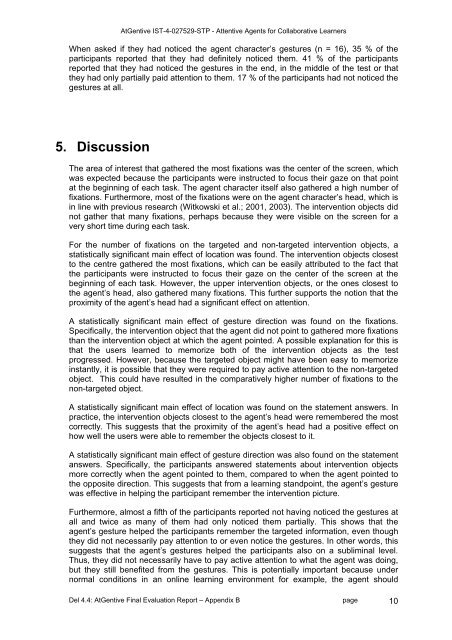Deliverable 4.4 - INSEAD CALT
Deliverable 4.4 - INSEAD CALT
Deliverable 4.4 - INSEAD CALT
You also want an ePaper? Increase the reach of your titles
YUMPU automatically turns print PDFs into web optimized ePapers that Google loves.
AtGentive IST-4-027529-STP - Attentive Agents for Collaborative LearnersWhen asked if they had noticed the agent character’s gestures (n = 16), 35 % of theparticipants reported that they had definitely noticed them. 41 % of the participantsreported that they had noticed the gestures in the end, in the middle of the test or thatthey had only partially paid attention to them. 17 % of the participants had not noticed thegestures at all.5. DiscussionThe area of interest that gathered the most fixations was the center of the screen, whichwas expected because the participants were instructed to focus their gaze on that pointat the beginning of each task. The agent character itself also gathered a high number offixations. Furthermore, most of the fixations were on the agent character’s head, which isin line with previous research (Witkowski et al.; 2001, 2003). The intervention objects didnot gather that many fixations, perhaps because they were visible on the screen for avery short time during each task.For the number of fixations on the targeted and non-targeted intervention objects, astatistically significant main effect of location was found. The intervention objects closestto the centre gathered the most fixations, which can be easily attributed to the fact thatthe participants were instructed to focus their gaze on the center of the screen at thebeginning of each task. However, the upper intervention objects, or the ones closest tothe agent’s head, also gathered many fixations. This further supports the notion that theproximity of the agent’s head had a significant effect on attention.A statistically significant main effect of gesture direction was found on the fixations.Specifically, the intervention object that the agent did not point to gathered more fixationsthan the intervention object at which the agent pointed. A possible explanation for this isthat the users learned to memorize both of the intervention objects as the testprogressed. However, because the targeted object might have been easy to memorizeinstantly, it is possible that they were required to pay active attention to the non-targetedobject. This could have resulted in the comparatively higher number of fixations to thenon-targeted object.A statistically significant main effect of location was found on the statement answers. Inpractice, the intervention objects closest to the agent’s head were remembered the mostcorrectly. This suggests that the proximity of the agent’s head had a positive effect onhow well the users were able to remember the objects closest to it.A statistically significant main effect of gesture direction was also found on the statementanswers. Specifically, the participants answered statements about intervention objectsmore correctly when the agent pointed to them, compared to when the agent pointed tothe opposite direction. This suggests that from a learning standpoint, the agent’s gesturewas effective in helping the participant remember the intervention picture.Furthermore, almost a fifth of the participants reported not having noticed the gestures atall and twice as many of them had only noticed them partially. This shows that theagent’s gesture helped the participants remember the targeted information, even thoughthey did not necessarily pay attention to or even notice the gestures. In other words, thissuggests that the agent’s gestures helped the participants also on a subliminal level.Thus, they did not necessarily have to pay active attention to what the agent was doing,but they still benefited from the gestures. This is potentially important because undernormal conditions in an online learning environment for example, the agent shouldDel <strong>4.4</strong>: AtGentive Final Evaluation Report – Appendix B page 10
















